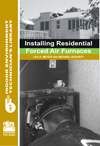
Modular
outdoor AHUs supply 62,000 cfm of supply air to the city of
Unalaska’s power house in extreme conditions.
Nothing is easy in the Aleutians. Thus, a project to install necessary air handlers for a power station on Unalaska was a challenge for the engineer and the manufacturer, Governair Corporation. Unalaska, the 11th largest city in Alaska, is a bustling community of about 4,000 residents located on Unalaska Island in the Aleutian Chain, approximately 800 miles southwest of Anchorage.
LOCATION NOW WORLD-FAMOUS
The Aleutians separate the stormy North Pacific and the equally turbulent Bering Sea. The flavor of Unalaska has become familiar to viewers of the popular Discovery Channel® program “The Deadliest Catch,” a reality TV program now in its sixth season and having a worldwide television following. The section of the city known as Dutch Harbor is the home port for the now-famous crab fishing fleet that takes high risks for high rewards in the stormy northern ocean waters.In recent years, changes in federal fishing regulations have created an extended fishing season, and the city of Unalaska has felt the effect in construction of new commercial facilities, and with that, a growth in electrical demand. To meet that need, the city made plans to purchase two 5.2 MW diesel units and to begin an expansion of its power house, a $48 million project. The project engineer was Electric Power Systems (EPS) of Anchorage. As part of the power plant project, EPS specified air handlers to supply the power house with combustion air, cooling, ventilation, and comfort conditioning. This element was a requirement of the generator manufacturer, the Finnish firm Wartsila.
ADEQUATE SPACE A CHALLENGE
Arrangements for the design, construction, and installation of the air handlers were handled by Bob Heym of Alaska Winter Inc., a CES Group® manufacturer’s representative in Anchorage. According to Heym, Wartsila had initially specified an indoor air handler system, but there was not adequate indoor space for such a system and its associated ductwork in the new power house. Instead, Heym suggested a modular outdoor system with openings in the building wall for the required supply and exhaust ducts.He had previous experience using such systems built by Governair® Corporation, a CES Group Company. The project bid in late 2008 and Governair was the successful bidder. According to David Lunow, application engineer with Governair, “Our ability to tailor a custom design suited to these extreme conditions made it an easy match.” Heym and a city representative went to the Governair factory in Oklahoma City to go over the submittals and to ensure that the finished product would meet the owner’s needs. A few changes were made at this point, including addition of a rail system in case it is ever necessary to remove a 300-lb motor. Another addition was installation of an aluminum tread plate floor.
SURPRISE WIND DESIGN REQUIREMENT
Late in the submittal process, it was mentioned that there was a requirement that the air handlers be able to withstand 175-mph winds. Somehow, this had been missed in developing the initial spec. The levels of storm winds in the Aleutians are legendary. As recently as December 2009, winter storm winds were officially recorded at 115 mph, and at Dutch Harbor, unofficial measurements reached 170 mph. Coffman Engineering of Anchorage was familiar with Governair packages, and was able to revise the plans to meet the changed wind speed spec.“Governair replaced standard 2-in. by 2-in. corner tubes with 6-in. by 6-in. tubes, and used additional 4-in. by 4.in. tubes for cross bracing support,” said Lunow “This kind of steel support, along with the stiff Governair panel construction, made it easy to meet the 175-mph wind load and zone 4 seismic requirements. We have done vertically stacked units before this job, but nothing that had to meet such extreme requirements.”
FOUR VERTICAL LEVELS
Lunow points out, “Governair built the two complete units with all the components mounted. We stacked the sections on top of each other to ensure everything lined up.” Each unit is able to supply 62,000 cfm of supply air, and is designed to be able to mix in return air, depending on outdoor conditions.The units are designed in four levels. The first floor is a three-sided louvered section to provide outside air and access to the unit. The second floor contains the filters and is the location of the control panel. The third floor contains one of the exhaust fan with its VFD. The fourth floor contains the supply fan and the second exhaust fan, along with the two fan VFDs. The supply fan for each unit is a vertical shaft plenum fan. These were assembled along with the fan frame at Governair. This type fan was selected because it fits the unit design and airflow requirement the best. The exhaust fans are prop fans. Governair performed the interior power wiring, with a single-point power connection and a disconnect switch. At the site, the control contractor installed the control wiring.
The first unit is already up and operating, and the second unit is nearing completion. Heym points out that because the unique characteristics and remoteness of this region, projects such as this often take longer than expected.
“A single missing part or a failed tool can bring the project to a halt for days. Add to that some very dynamic weather and a limited number of skilled workers, and it is a challenge,” he said. These are some of the reasons that maximum factory assembly of the units was desired. Nancy Peterson, director of public works for the City of Unalaska states, “The City of Unalaska is pleased that Governair was able to meet the specifications required for this important project.”
The remote location and the strenuous wind and seismic requirements at Unalaska are unusual, but this project points out the importance being able to customize packaged air handler designs to meet specific local conditions. The key to success is the combination of local knowledge and a manufacturer able to deliver a package that meets those conditions. ES







